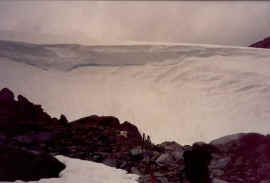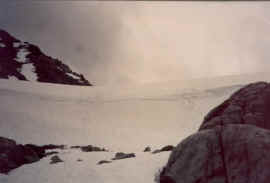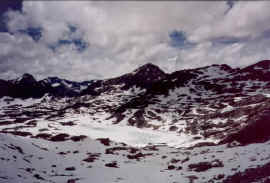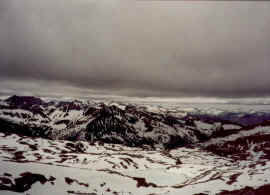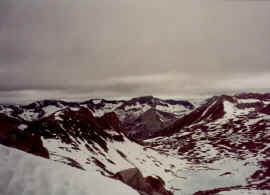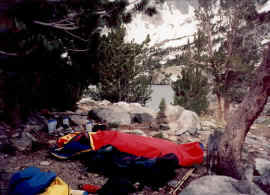Lose 14 pounds in 5 Days! By Craig Adkins
To have the fullest Sierra experience I decided to try to bag a peak in the
Palisades. This is the highest region of the Sierras in terms of continuous
land mass, with six named peaks over 14,000 in height. The last week of
June was selected for the attempt because the snow would be firm enough
to walk on, presumably no new snow would be falling, and days are longest
during this time of year.Day 1:
Driving west from Bishop I arrived at South Lake, loaded my expedition
pack with an ambitious 75 pounds of backpacking and climbing gear and set
off toward Bishop Pass. Due to the late start it was only about 3 miles before
I set up camp 1.Day 2:
After a few hours I passed tree line, leaving vegetation behind for a while, and came to the Bishop Pass headwall. An imposing sight after a 140% snow pack season.Strapping on crampons, which were to remain on until getting back to this point on the way out, I was thankful my ice axe was 100cm long. Climbing steep snow is not a place to fall backwards.
After getting past the headwall I made camp at the border of Dusy Basin.Day 3:
Hiking across Dusy Basin I ascended Thunderbolt Pass and descended into the upper section of Palisade Basin, traversing the bottom southwest slopes of Thunderbolt Peak 14,003', Starlight Peak 14,200', and North Palisade !4,242'.
As the big walls of Yosemite are the ultimate in California rock climbing , so is North Palisade the ultimate in mountaineering.The approach hike from the Northeast or the Southwest, the skills required with snow and ice, the altitude, the view, and the fact that even its easiest routes are difficult make it the ultimate prize.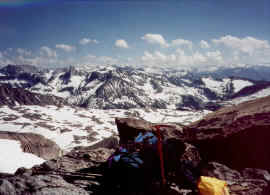
view from Palisade Basin looking south.
My summit shots are currently floating in the ether but I'll be sure to share them with you ASAP.Day 3: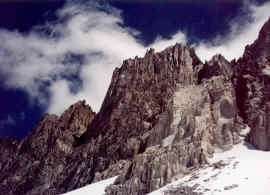
south side of North Palisade.
After traversing a steep snow slope in Palisade Basin the ground became more level but melting snow doesn't support weight and I started taking multiple falls through 5 feet of snow onto unseen granite terrain. The shock of falling, the effort of then extricating myself , and the wetness were together creating a definite setback. But there seemed to be no other choice but to bull my way through.
I soon reached Potluck Pass and set up camp. Bivy bag camping is great when the weather is fine but not during a storm. Being knackered from the rotten snow patch, no tent in a steady 30 mph wind, and being wet was so devastating that I went to sleep, not having the energy to make dinner. Truly ominous
.
Day 4: Escape
As soon as I woke I ditched a rope, packed up and started the retreat. I managed to avoid the rotten snow section and passed Palisade Basin with a different view on the way out.Day 4: Retreat
Below is a picture of Dusy Basin from Thunderbolt Pass on the way out. After passing Bishop Pass and getting back down to trees I was literally out of the death zone.Setting up camp in the shelter of trees, on the leeward side of the crestline, was like checking into a five star hotel. I ate until I was stuffed, had a great sleep and got back to the truck on day 5.Unfortunately the fourteen pounds didn't stay off, but looking back on it all, I'm glad I wasn't all that skinny at the onset.
